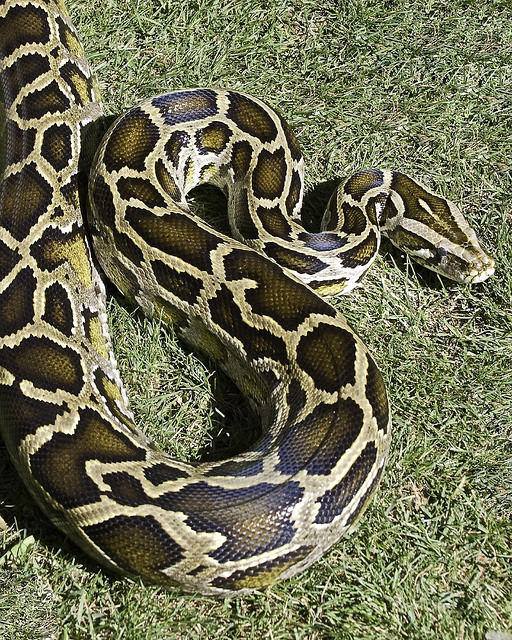
Section Branding
Header Content
Invasive Species: Burmese Pythons May Be Slithering Up To A Backyard Near You
Primary Content

The Burmese python doesn’t belong here in Georgia, but good luck keeping it out.
The huge yellow and black snakes are invading the Everglades, but they are on the move, possible to this state.
“They are making their way out because there are so many in the Everglades right now that they need more room,” said Sharon Collins, host and executive producer of Georgia Outdoors on GPB. “They’ve just about completely wiped out the raccoon population, the possum population. If it gets under a rookery or egrets or wood storks- bye bye.”
‘Invaders”, the newest episode of Georgia Outdoors, is about species that are putting our native flora and fauna in jeopardy. One of these nefarious species is the Burmese python.
Preying on deer and alligators, the snakes can grow to massive sizes. Collins says some of the pythons have even been found with bobcat claws in their stomachs.
Hurricanes travelling to the southeastern part of Florida blew the snakes over from the east. But, pet owners in Florida are also to blame for the snakes’ Everglades invasion.
“They were very popular as pets. Even the people now trying to get rid of them say ‘I love these things’ .”
Collins traveled to Florida to learn how to capture on of the pythons.
“They have volunteers trained now so if you spot one, you can go out and bag it.”
Invasive species aren’t just slithering up from Florida. Some of the pests in Georgia are making their way down to the sunshine state.
“There’s a tiny beetle called the redbay ambrosia beetle and it carries fungus in its cheeks. It deposits that fungus into the trees,” said Collins. “ Almost all of our Red Bay Trees, sort of icons of the southern coast, are just about gone because this beetle makes burrows, deposits its fungus to eat later, and as soon as the tree attacks that fungus, it shuts the sap flow and basically starves itself to death.”
That fungus is the Laurel Wilt fungus.
The redbay ambrosia beetle has now moved down into Florida and is attacking the avocado groves. Farmers in Florida are frantically trying to stop the spread.
First detected in the U.S. in 2002, the beetles came over on a shipping crate from Port Wentworth, Georgia. Since then, they have continued to arrive on plant nursery stock and shipping crates.
Collins says the plump pests can even been transported state to state on potted plants.
“You have to think twice. Even if you have potting soil and let’s say you want to take a potted plant up to a friend in Pennsylvania, don’t do it. Because you don’t know what might be in that potting soil. Even firewood. Just don’t do it.”
Natural disasters aren’t the only cause of the species invasion. The infestation is also a result of our U.S. global economy, trading from continent to continent. And once these pests arrive here from other countries, it’s hard to get rid of them.
“So many of these things do come in on wooden shipping crates. A lot of them come from Asia. Over there, they have predators. They come here, there’s no predator. There’s nothing to balance out the ecosystem. So they just have full range,” said Collins.
One example is the woolly adelgid, a pest that invades hemlock trees.
“They’re trying to work with some beetles that might eat the wooly adelgid. But right now, there is a chemical they can inject in the roots,” said Collins. “But try to do a whole forest.”
Georgia Outdoors “Invaders” premieres Friday, April 25 at 8:30 p.m.
Tags: Georgia Outdoors, wooly adelgid, burmese python, the Everglades, redbay ambrosia beetle
